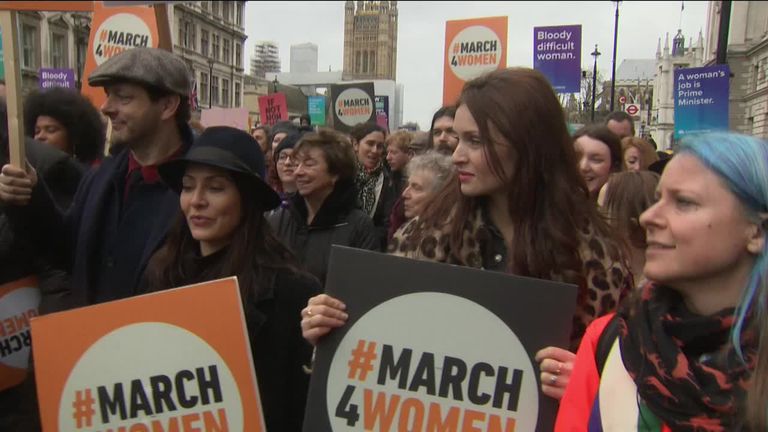Q&A: Gender pay gap explained as reporting deadline looms
Your questions answered as 9,000 employers face a Thursday deadline to publish data covering how they reward men and women.
Wednesday 4 April 2018 14:19, UK
The clock is ticking down to midnight today when larger employers must have submitted gender pay figures to the Government. What, simply, is it all about?
:: What is the gender pay gap?
The gender pay gap is calculated as the difference between the average salaries of men and women.
It is not the same as equal pay, where firms are required to pay people doing the same job the same salary regardless of gender.
Experts say that the disparities reflect other factors such as more men being in higher-paid roles and other potential forms of discrimination.
:: What has the Government forced employers to do?
In an effort to understand the pay gap better - and perhaps shame the worst offenders into action - companies and charities employing 250 or more people have until Thursday to upload their gender pay data to a database.
Search for a company .
The deadline for public bodies has already expired.
The submission covers pay, bonuses and the proportions of male and female employees in a company's lower, lower middle, upper middle and upper pay bands.
The exercise will be repeated to chart progress closing gender pay gaps.
:: What will happen if a company ignores the request?
It is a legal requirement and the Equality and Human Rights Commission (EHRC) says those failing to publish their figures on the database would be given a further opportunity before facing the prospect of an unlimited fine.
There is no official number but it is understood that around 9,000 employers are obliged to hand over their data.
As of Wednesday afternoon, more than 9.200 had done so.
:: How is the main gender pay gap calculated?
There are two ways which employers must follow to comply. There must be a mean and a median figure.
'Mean' does not mean 'how mean' a company is. The mean figure is calculated by adding all the salaries of an employer by gender and then dividing that sum by the number of salaries.
The 'median' is the middle figure found in the set of salaries and is seen as the fairest reflection by many experts because it is less prone to be skewed by a small number of high earners.
:: Can I have an example?
We have picked a company at random - .
Its sample was taken on 5 April 2017 - a time when it was run by Dame Carolyn McCall, who is now chief executive of ITV.
The airline's submission showed that its median hourly pay rate was 45.5% lower for women. It means that, under the measure, women earn 54p for every £1 that men earn.
Easyjet's lower-paying roles were occupied by almost 70% of women while its top management roles were almost 90% male.
While almost 90% of female staff received bonuses compared with 75% of men, women's median bonus pay was 32.2% lower than men's.
It is also worth noting - though not contained in the data - that Johan Lundgren took a pay cut of £34,000 when he succeeded Dame Carolyn at the no-frills carrier to ensure his pay was maintained at her level.
:: Why has the gender data deadline proved controversial?
The key criticism is that no definitive list of bodies has been published to determine which organisations have to report their data.
Another has centred on the fact companies are inputting data themselves - leading to obvious mistakes in the submissions. There is also no commentary alongside the bare numbers to explain the stats.
:: What can be achieved through this process?
The Government's intentions are unclear at this stage.
There will be considerable pressure within organisations to address disparities - particularly if they are seen by critics as falling foul of the law on equal pay.
Others see it as the #MeToo moment for gender pay.
Labour MP Stella Creasy has launched a #PayMeToo movement with other MPs to advise women on closing the gender pay gap.








